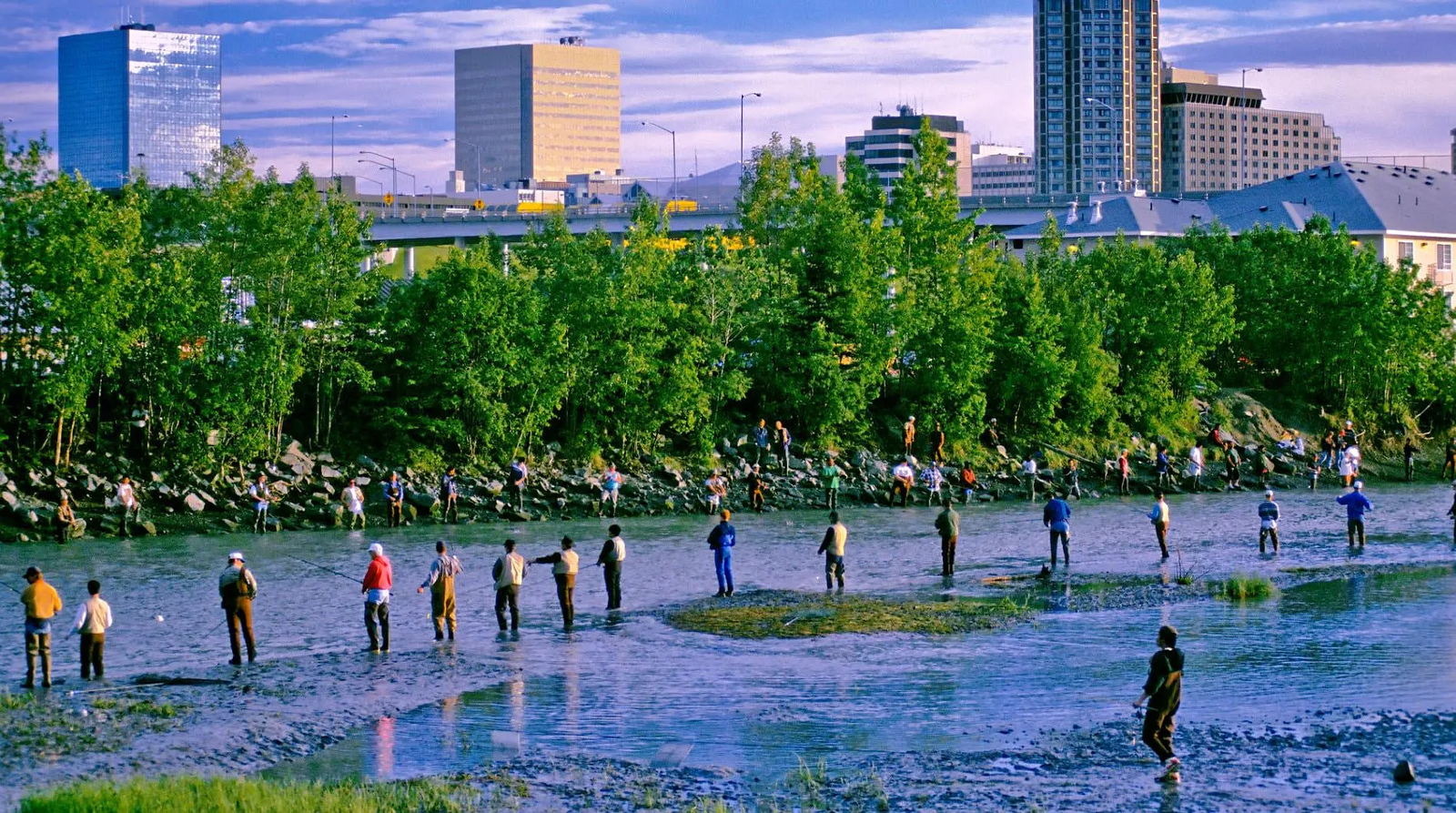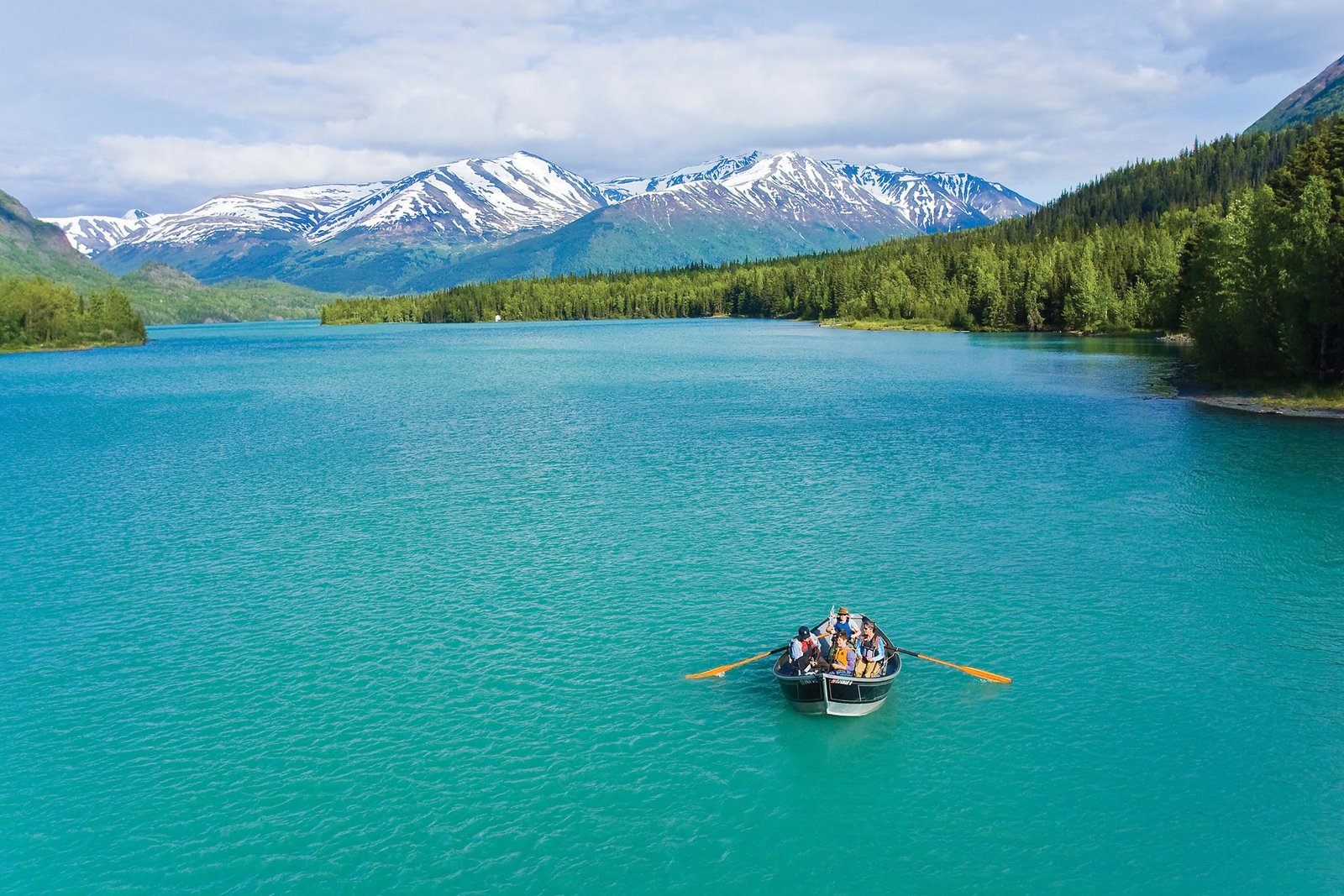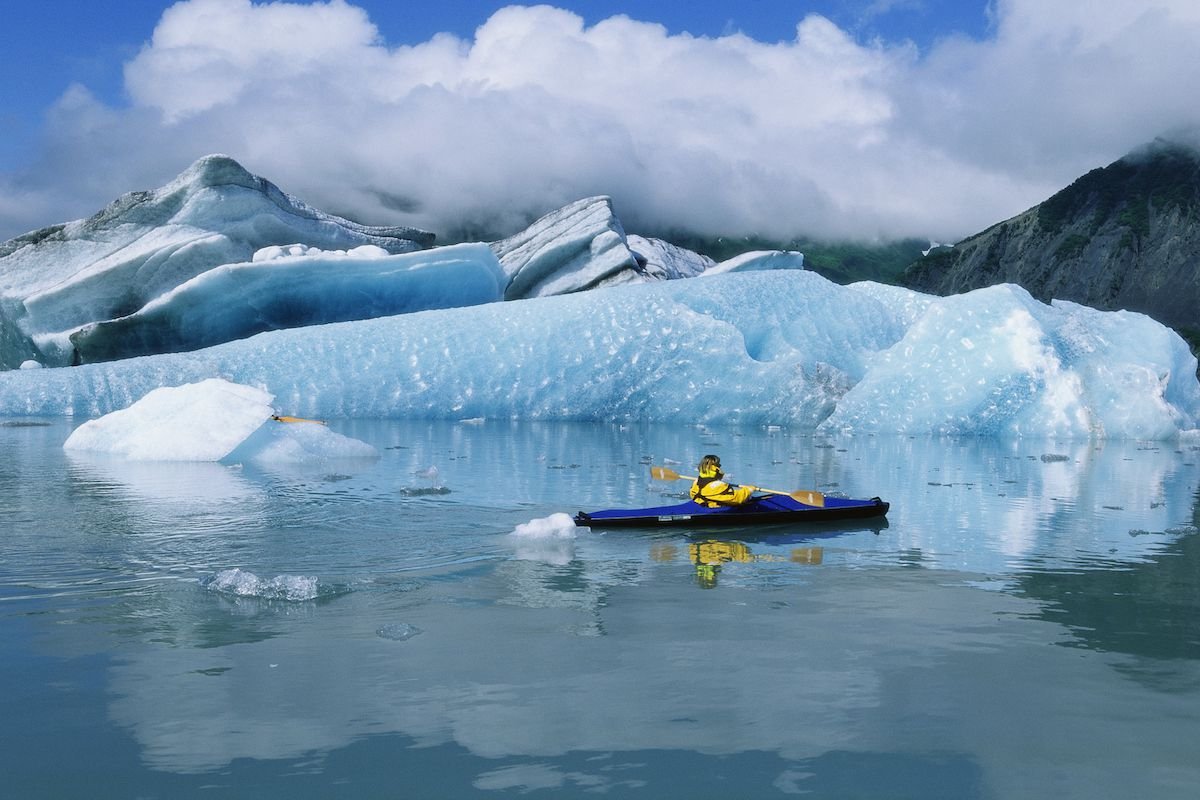Alaska’s largest city, Anchorage, is a scenic gateway to the state’s awe-inspiring wilderness and mountain ranges. But beyond its access to Chugach State Park, Denali, and other prized destinations, Anchorage itself has plenty of fantastic attractions.
| Attraction | Description |
|---|---|
| Alaska Native Heritage Center | Cultural museum highlighting Alaska’s indigenous groups with exhibits, performances, and traditional dwellings. |
| Anchorage Museum | Alaska’s largest museum showcasing art, history, and indigenous cultures. |
| Kincaid Park | A 1,400-acre park on Cook Inlet with trails, wildlife, and scenic views. |
| Flattop Mountain Trail | A hiking trail offering panoramic views of Anchorage and surrounding areas. |
| Tony Knowles Coastal Trail | An 11-mile trail along Cook Inlet for walking, running, and cycling. |
| Alaska Zoo | A zoo focusing on Arctic and subarctic species. |
| Anchorage Museum of History and Art | Exhibits on Anchorage’s history and Alaskan art in the historic downtown area. |
| Aviation Heritage Museum | Museum dedicated to Alaska’s aviation history with various aircraft and simulators. |
| Alaska Botanical Garden | A 110-acre garden with native plants, themed gardens, and seasonal events. |
| Potter Marsh Bird Sanctuary | A wildlife viewing area with a boardwalk for birdwatching and nature observation. |
| Chugach State Park | A large state park near Anchorage with diverse landscapes and recreational activities. |
From expansive nature parks to top-notch cultural sights, Anchorage offers many things to see and do. Here are 12 of the best attractions that no visit to Anchorage is complete without experiencing.
Alaska Native Heritage Center

Name and Location: Alaska Native Heritage Center, located in Anchorage.
History and Significance: Cultural center opened in 1999 featuring exhibits on Alaska Native tribes, art, traditions. Shares and preserves the history and traditions of Alaska Natives.
What to Expect: Outdoor exhibits representing village life, interpretive trails, cultural performances, art galleries, restaurant. Immersive educational experiences about Native Alaskan cultures.
Visitor Information: Open daily May-September. Reduced hours rest of year. Admission fee charged. Onsite parking.
To gain insight into Alaska’s indigenous cultures, the Alaska Native Heritage Center is an absolute must-visit. This interactive museum and cultural center spotlights the traditions of 11 native Alaskan groups via exhibits, performances, demonstrations, and more. Visitors can observe traditional dance presentations, listen to Native song and storytelling, and meet community elders. Extensive exhibits showcase traditional tools, arts, clothing and more while highlighting the resilient heritage of Alaska’s first peoples. The Hall of Cultures details each group’s history and lifeways. Outdoors, examples of traditional dwellings dot the grounds. This celebration of indigenous Alaskan culture provides invaluable education and perspective.
Anchorage Museum

Name and Location: Anchorage Museum, located in downtown Anchorage.
History and Significance: Major museum with exhibits covering Alaskan art, history, Native culture. Contains Alaska’s largest collection of Native artifacts. Founded in 1968.
What to Expect: Extensive galleries with Alaska-focused displays. Smithsonian Arctic Studies Center. Planetarium shows. Cafe and museum store onsite.
Visitor Information: Open daily. Admission fee charged. Parking garage connected to museum.
As Alaska’s largest museum, the Anchorage Museum offers an expansive look at the state’s art, history, cultures and landscapes. Historic and contemporary art is displayed along with traveling exhibitions covering wide-ranging topics. Extensive exhibits on Alaska’s indigenous peoples include objects like ivory carvings, fishing tools, masks and more. Visitors can see recreations of historic settings and lifestyles, from Native camps to early pioneer settlements. Natural history dioramas showcase Alaska’s abundant wildlife. The Smithsonian Arctic Studies Center onsite highlights northern ecosystems and research. With its vast collection spanning 6 galleries, the museum provides exceptional insight into Alaska’s past, present and future.
Kincaid Park

Name and Location: Kincaid Park, located in western Anchorage near the coast.
History and Significance: Huge park containing coastal trails, disc golf, soccer fields and more. Offers many outdoor recreation opportunities with beautiful scenery.
What to Expect: Trails for hiking, mountain biking, cross-country skiing. Wildlife viewing areas. Breathtaking coastal views.
Visitor Information: Open year-round. No entrance fee. Parking areas located throughout the park.
Encompassing over 1,400 acres on the Cook Inlet coastline, Kincaid Park offers panoramic views along with outstanding outdoor recreation opportunities. The expansive green space invites explorations by foot, bike, ski, skates – the park contains over 40km of trails catering to various pursuits. Diverse vegetation ranges from spruce and birch forest to flower filled meadows. Visitors can fish at Lake Spenard, observe local wildlife, play disc golf, enjoy picnics and much more. Scenic overlooks regard views of the Chugach Mountains and Cook Inlet, especially resplendent during fall foliage season. For experiencing Anchorage’s magnificent landscapes up close, Kincaid Park is unmatched.
Flattop Mountain Trail

Name and Location: Flattop Mountain Trail, located in Chugach State Park near Anchorage.
History and Significance: One of the most popular and challenging day hikes in Anchorage, leading to the summit of Flattop Mountain. Incredible scenery reward.
What to Expect: Approximately 3 mile steep hike with rocky sections. Scrambling required at the top. Sweeping 360° mountain and city views from the summit.
Visitor Information: Access year-round from Glen Alps trailhead near Anchorage. No state park fee.
For an iconic Anchorage hike with phenomenal panoramas, the Flattop Mountain Trail can’t be topped. Ascending 1500 feet over 3 miles of moderate switchbacks and rugged terrain, the trail culminates in sweeping 360 degree vistas from the flattened summit. Trekkers can gaze out at Cook Inlet, the Chugach and Talkeetna mountain ranges, and downtown Anchorage in the distance. Wildlife sightings may include Dall sheep, bald eagles, marmots and ptarmigan. Moderate fitness is required but the breathtaking views make the climb well worth it. Hiking Flattop is a rite of passage for Anchorage residents and visitors alike.
Tony Knowles Coastal Trail

Name and Location: Tony Knowles Coastal Trail, stretching along the Anchorage coastline.
History and Significance: Scenic paved multi-use trail hugged between the mountains and Cook Inlet. Popular for walking, biking, running, and views.
What to Expect: Over 10 miles of continuous trail with spectacular coastal scenery. Benches, viewing platforms, and access points along the way.
Visitor Information: Accessible year-round. No fee to use. Parking at trailheads and access points along the route.
Stretching 11 picturesque miles along the Cook Inlet shoreline, the multi-use Tony Knowles Coastal Trail is perfect for walking, running, cycling or in-line skating with lovely maritime views all along the way. The mostly flat, paved trail begins at 2nd Ave downtown and winds past parks, lagoons, and natural habitats as it traces the coast. Visitors can watch the tides of Cook Inlet come in and out, gaze at the Chugach Mountains, and appreciate the striking blend of urban cityscape and natural beauty. Benches, picnic areas, and scenic overlooks allow opportunities to pause and take in the environment. For an effortless way to experience Anchorage’s coastal beauty, the Tony Knowles Trail can’t be beat.
Alaska Zoo

Name and Location: Alaska Zoo, located in Anchorage.
History and Significance: Small zoo opened in 1969 displaying native Alaskan wildlife. Features animals like bears, moose, musk ox, caribou in natural habitats.
What to Expect: See and learn about Alaska’s wildlife up close. Kid-friendly educational experience. Concessions and gift shop onsite.
Visitor Information: Open daily May through September. Reduced hours rest of year. Admission fee charged.
Families and animal lovers shouldn’t miss the unique opportunity to visit the Alaska Zoo and encounter northern wildlife up close. As the only zoo in the United States located in a subarctic climate, it focuses exclusively on Arctic and subarctic species. Visitors can observe Alaskan icons like brown and black bears, caribou, moose, musk oxen, Dall sheep and wolves in naturalistic habitats. The zoo also rescues and houses injured local fauna including lynxes, foxes, porcupines and more. Special programs allow visitors to aid in caring for the animals. Given Alaska’s abundant natural wildlife, the zoo provides an invaluable chance to safely view and learn about these remarkable northern creatures.
Anchorage Museum of History and Art

Name and Location: Anchorage Museum of History and Art, located in downtown Anchorage.
History and Significance: Major cultural institution exhibiting Alaskan art and historical artifacts. Contains many native Alaskan collections and hosts traveling exhibits.
What to Expect: Extensive galleries displaying Alaskan art, history and culture. Research archives, planetarium, programs and events. Museum store and cafe.
Visitor Information: Open daily. Admission fee charged. Parking garage connected to the museum.
Housed in the historic Wells Fargo bank building in downtown, this museum brings Anchorage’s past to life through engaging exhibits and displays. Permanent galleries feature historic photos showcasing Anchorage’s growth from native settlements to present day metropolis. Anchorage’s role in WWII is highlighted via artifacts, accounts, and interactive displays. Galleries dedicated to Alaskan art include traditional Inupiaq masks, baleen baskets, paintings of landscapes, contemporary mixed media, and more. The climbing wall on the museum’s exterior celebrates Anchorage’s frontier spirit. For an immersive look at the city’s history and cultural creativity, this downtown museum is a must see attraction.
Aviation Heritage Museum

Name and Location: Aviation Heritage Museum, located at Ted Stevens Anchorage International Airport.
History and Significance: Displays a collection of aviation history artifacts significant to Alaska. Contains vintage aircraft and commemorates Alaskan bush pilots.
What to Expect: See and explore historic Alaskan aircraft and aviation exhibits. Highlights the pilots who opened up Alaska by air. Gift shop onsite.
Visitor Information: Open daily May through September. Free admission but donations encouraged. Located at airport near Lake Hood.
As the largest aviation museum in the state, this facility spotlights Alaska’s rich history of flight and wartime contributions. Over 75 aircraft and exhibits detail bush pilots, early mail carriers, military operations and record-setting aviators who helped open up Alaska to the world. Historic bush planes, bombers, fighter jets and more represent milestones in Arctic aviation. Engaging displays convey how aircraft shaped life and commerce through Alaska’s inaccessible terrain. Simulators let visitors try navigating virtual planes on missions. For both aviation buffs and novices desiring a glimpse of Alaska’s air history, a visit here is time well spent.
Alaska Botanical Garden

Name and Location: Alaska Botanical Garden, located in Anchorage.
History and Significance: Botanical garden showcasing Alaska native plants and hardy perennials. Established in 1993. Features trails and educational programs.
What to Expect: Trails winding through diverse botanical collections and natural areas. Wildflowers, perennial garden, herb garden, greenhouse.
Visitor Information: Open May through September. Admission fee charged. Free parking onsite.
Spanning 110 picturesque acres, the Alaska Botanical Garden provides an enchanting oasis of vibrant blooms and tranquility. Flower-filled beds, informal wooded trails, ponds and waterfalls make up this urban escape which highlights native species and hardy northern cultivars. Themed gardens range from a woods walk featuring native plants to perennial beds, herb and alpine rock gardens. A children’s garden incorporates mini bridges and fairy houses. Events include summer music concerts, photography workshops and botanical art exhibits. For pure seasonal delight, a wander through the garden’s floral beauty is sure to impress.
Potter Marsh Bird Sanctuary

Name and Location: Potter Marsh Bird Sanctuary, along the Seward Highway south of Anchorage.
History and Significance: Protected wetlands providing critical habitat for thousands of migratory birds along the Pacific Flyway. Excellent birdwatching spot.
What to Expect: Huge concentrations of migratory birds in spring and fall. Observation decks for spotting different species along the marsh trails.
Visitor Information: Open year-round. Pullouts along highway for wildlife viewing. Best visited April – October.
Managed by the Anchorage Audubon Society, the Potter Marsh Bird Sanctuary offers premier wildlife viewing in the heart of the city. A 600-foot accessible boardwalk spans parts of the marsh, inviting observation of migratory birds and spawning salmon. Over 140 bird species have been sighted in the wetlands, including ducks, geese, swans, sandpipers and raptors. Interpretive displays educate visitors about the cycles of birds, fish and plant life throughout the seasons in this special ecosystem. Early mornings and evenings provide ideal viewing opportunities. For an urban oasis of tranquil birdwatching, Potter Marsh is an Anchorage treasure.
Chugach State Park

Name and Location: Chugach State Park, near Anchorage.
History and Significance: One of Alaska’s most accessible state parks, offering year-round recreation amid mountains, lakes and streams. Includes part of the Chugach Mountain Range.
What to Expect: Camping, hiking, biking, fishing, skiing and snowshoeing trails. Backcountry recreation in a wilderness setting minutes from Anchorage.
Visitor Information: Open year-round. Day use fee or parking pass required. Multiple access points from Anchorage.
Offering easy access to abundant wilderness right outside the city, Chugach State Park is Anchorage’s cherished backyard playground. Just minutes from downtown, the 495,000 acre park contains alpine and glacial scenery, rushing rivers, cascading waterfalls, 100+ miles of hiking trails, campgrounds and more. Highlights include glacier hikes on Matanuska and Spencer Glaciers and treks to crowning peaks like Mt. Williwaw and Flattop Mountain. Camping spots range from backcountry to RV accessible. Wildlife sightings may include Dall sheep, moose, bears, and soaring eagles. For experiencing Alaska’s stunning landscapes in convenient proximity, Chugach’s beauty and recreation entice year-round.
Conclusion
From urban green spaces like Kincaid Park to trailblazing hikes like Flattop, Anchorage’s wealth of attractions offer nature immersion, cultural experiences, and scenic vistas all within reach. Museums like the acclaimed Anchorage Museum and unique Alaska Native Heritage Center illuminate the state’s indigenous traditions and art. Family-friendly destinations including the Alaska Zoo and Aviation Heritage Museum engage through interactions with animals and historic aircraft. And Chugach State Park’s endless wilderness sits right on Anchorage’s doorstep. Visitors will quickly find that Alaska’s largest city provides access to the state’s most coveted attractions.





Join the Conversation